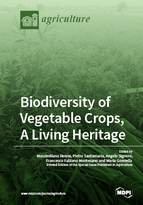Biodiversity of Vegetable Crops, A Living Heritage
A special issue of Agriculture (ISSN 2077-0472).
Deadline for manuscript submissions: closed (31 May 2018) | Viewed by 69277
Special Issue Editors
Interests: vegetables quality; agrobiodiversity; biofortification of vegetables; wild edible plants; underutilized crops
Special Issues, Collections and Topics in MDPI journals
Interests: agrobiodiversity; vegetable production; greenhouse production; plant nutrition; soilless culture; vegetable quality; nitrate
Special Issues, Collections and Topics in MDPI journals
Interests: biofortification of vegetables; soilless cultivation technique; microgreens production; exploitation of underutilized crop and wild edible plants; light spectrum effect on leafy vegetables; plant nutrition; informatic tools related to (agro)biodiversity; Nitrates
Interests: greenhouse cultivation techniques; soilless cultivation techniques; sensor-based fertigation management in horticulture; improvement of water use efficiency in horticulture; mineral plant nutrition; biofortification of vegetables
Special Issues, Collections and Topics in MDPI journals
Interests: morphological and nutritional evaluation of agro-biodiversity; market and nutritional quality of vegetable crops; plant nutrition; nitrate content; greenhouse and soilless cultivation
Special Issues, Collections and Topics in MDPI journals
Special Issue Information
Dear Colleagues,
Intensive agriculture has generally resulted in higher productivity, but also in a trend towards decreasing levels of agro-biodiversity, which preservation represents a key-point to assure adaptability and resilience of agro-ecosystems to the global challenge to produce more and better food in a sustainable way. Many components of agro-biodiversity would not survive without the human interference, but human choices may also represent a threat for the agro-biodiversity preservation.
The biodiversity in vegetable crops is composed by the genetic diversity, as species diversity (interspecific diversity) and as diversity of genes within a species (intraspecific diversity) referring to the vegetable grown varieties, and by the diversity of agro-ecosystems (agro-biodiversity). Intraspecific diversity is very ample in vegetable crops and is not reflected, at least not to the same extent, in other groups of crops. The labor operated by farmers over centuries of selection has led to the creation of a plurality of local varieties, following domestication of cultivated forms, and wide agro-biodiversity, a precious heritage both from a genetic and a cultural-historical point of view. Therefore, the agro-biodiversity related to vegetable crops has assumed very articulated connotations. It is also important to specify that a “local variety” (also called: landrace, farmer’s variety, folk variety) is a population of a seed or vegetative-propagated crop characterized by greater or lesser genetic variation, which is however well identifiable and which usually has a local name.
In facing the challenges of the modern vegetable growing sector, the many expressions of vegetable biodiversity are a key source for genetic improvement programs, to produce innovative vegetables with improved qualitative characteristics (crop diversification and new crops), to realize more environmentally sustainable agro-systems, to cope with issues of climate change, to find better adaptation to marginal soil conditions (salinity, atmospheric pollutants, etc.), not forgetting the need to recover and maintain links with history and folk traditions.
Unfortunately, the genetic diversity of vegetable crops in many world regions has been eroded, due to several factors such as abandonment of rural areas, ageing of the farming population, failure to pass information down the generations (leading to loss of knowledge and historical memory), which can vary in relation to the type of genetic resource and location.
In this view, it is important to create a biodiversity network to promote the exchange of information between stakeholders to facilitate the diffusion and protection of these genetic resources by: collecting and preserving memories and knowledge of biodiversity in vegetable crops; retrieving and identifying such landraces within the territory; characterizing, cataloguing and preserving them. On the other hand, it must be underlined that the conservation of genetic biodiversity must be based not only on institutional and private plant breeders and seed banks, but mainly on the vast number of growers who continuously select, improve, and use vegetable biodiversity at the local scale. This availability of in situ biodiversity may be able to meet not only the requirements of breeders but also the needs of specific niche markets, such as those in which there is high demand for local products grown with environmentally-friendly farming techniques.
This Special Issue intends to cover the state-of-the-art, recent progress and perspectives in different aspects related to the biodiversity of vegetable crops. All types of manuscripts (original research, reviews, short communications, letter to editor and discussion) are welcome.
Articles may include, but are not limited to, the following topics:
- Ethnobotany of local variety and wild edible plants
- Domestication and crop evolution
- Morphological, physiological, biochemical and genetic analysis
- Gene bank management
- Reports of collecting missions
- Project update regarding in situ conservation
- Quality evaluation and exploitation
- Ecological, social and economic implications of agro-biodiversity preservation/decline
- Policies
Dr. Massimiliano Renna
Prof. Pietro Santamaria
Dr. Angelo Signore
Dr. Francesco Fabiano Montesano
Dr. Maria Gonnella
Guest Editors
Manuscript Submission Information
Manuscripts should be submitted online at www.mdpi.com by registering and logging in to this website. Once you are registered, click here to go to the submission form. Manuscripts can be submitted until the deadline. All submissions that pass pre-check are peer-reviewed. Accepted papers will be published continuously in the journal (as soon as accepted) and will be listed together on the special issue website. Research articles, review articles as well as short communications are invited. For planned papers, a title and short abstract (about 100 words) can be sent to the Editorial Office for announcement on this website.
Submitted manuscripts should not have been published previously, nor be under consideration for publication elsewhere (except conference proceedings papers). All manuscripts are thoroughly refereed through a single-blind peer-review process. A guide for authors and other relevant information for submission of manuscripts is available on the Instructions for Authors page. Agriculture is an international peer-reviewed open access monthly journal published by MDPI.
Please visit the Instructions for Authors page before submitting a manuscript. The Article Processing Charge (APC) for publication in this open access journal is 2600 CHF (Swiss Francs). Submitted papers should be well formatted and use good English. Authors may use MDPI's English editing service prior to publication or during author revisions.
Keywords
- Agro-biodiversity
- Wild edible plants
- Neglected and underutilized crop
- Local varieties
- Intraspecific diversity
- Gene pool
- Polymorphism
- Germoplasm
- Phenotyping
- Mapping
- Seed savers
- Descriptors
- Quality
- Exploitation
- History
- Traditions










